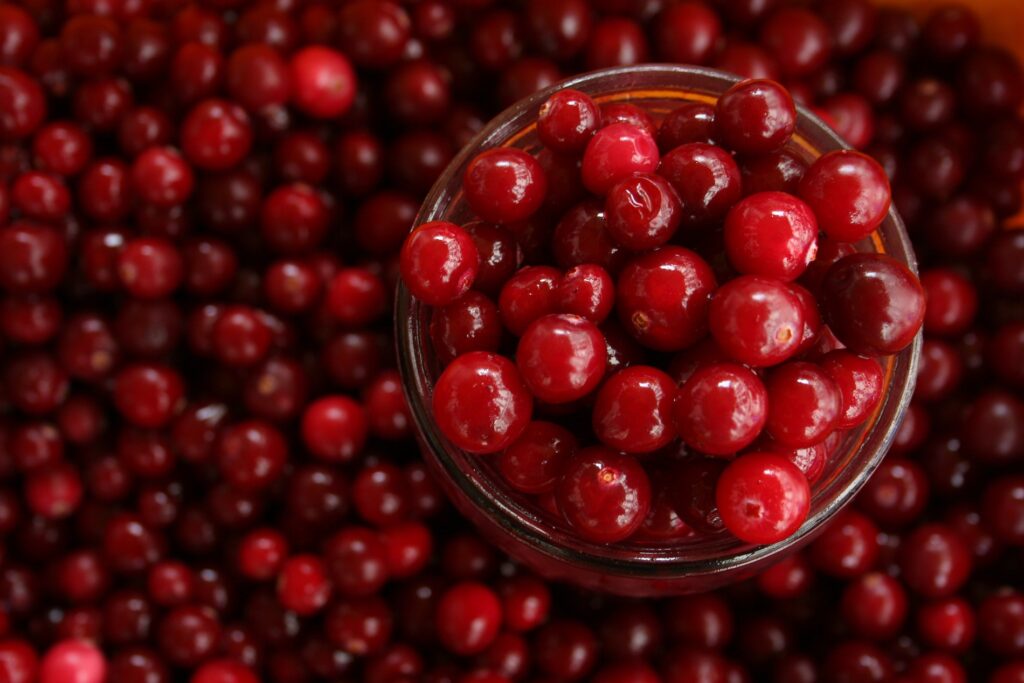Urinary tract infections (UTIs) are not fun. For anyone. They are caused by microorganisms (usually bacteria) that invade a normally sterile environment of the urinary canal, usually from the outside environment and may travel up to the bladder and kidneys. They are more common in women than in men, due mostly to the shorter pathway (urethra) into the body.
The number one culprit is the E.coli (Escherichia coli) bacteria normally colonizing in the human intestines and present in the fecal matter. The leading causes of UTIs are cross-contamination of the bodily orifices that are close to each other, and the E.coli becoming pathogenic in the urinary tract.
So, now that we know a little bit about the pathophysiology of UTIs, let’s talk about symptoms, prevention and treatment.

Fresh cranberries are good in theory, but you’d need to eat a whole lot to get equivalent doses to the supplements
HOW DO YOU DIAGNOSE UTIS?
Symptoms include dull pain in the lower abdomen, sense of urgency or incomplete voiding, burning sensation during urination, blood in urine.
Definitive diagnosis can be obtained by performing a urinalysis (analysis of a urine sample) to test for various markers of bacteria, white blood cells and evidence of inflammation or blood. A quick dipstick test can be performed to test for the main markers of UTIs (works like a combination litmus paper that indicates the presence of reagents that we are testing for). You can even get at at-home test kit here*.
HOW TO PREVENT UTIS
As you probably guessed, the number one prevention is hygiene (down there!). Proper hygiene of the genital areas consists of wiping away from the urinary tract after voiding (careful not to cross-contaminate with the anus), washing with a mild pH-appropriate soap regularly, and voiding/washing up before and after intercourse.
HOW TO NATURALLY MANAGE UTIS
-
Hydrate! The more water you drink, the better you will flush out all the bacteria/toxins via the urinary tract. I know it hurts and it may be uncomfortable to pee, but that’s the entrance point has to be the exit. That’s why we have increased urgency to pee when the body senses infection.
-
Cucumbers – are very hydrating, and will help you get the needed water and electrolytes into the body when you are tired of gulping plain water down.
-
Avoid caffeine, chocolate, sugar and alcohol. Caffeine and chocolate irritate the urinary tract, which can be unpleasant in an already hot situation. Sugar in any form feeds the bacteria and allows it to live on and multiply. Alcohol usually breaks down into sugar and makes the situation worse.
-
Cranberry extract or D-mannose powder (the active constituent in cranberries) – coats the walls of the urinary canal in a slimy film to prevent the bacteria from sticking to anything. I don’t recommend the juice or dried cranberries as they usually contain a lot of sugar (and additives). Fresh cranberries are good in theory, but you’d need to eat a whole lot to get equivalent doses to the supplements. (I like the HerbPharm cranberry tincture or Sonora capsules, and NowFoods d-mannose powder or capsules.)
-
Good urinary probiotic, such as RePhresh, that will inoculate the urinary tract with beneficial bacteria and competitively drive out the pathogenic invader.
-
High dose vitamin C (2-4 grams, up to 4 times daily) to help boost immunity and acidify urine to make the environment unfavorable for bacteria (however, this may cause more burning sensations during voiding). Foods high in vitamin C include dark green leafy vegetables, parsley and thyme, peppers, guava, kiwi, citrus fruit and berries. I also love vitamin-C packed herbal powders of rosehips, amla berry and hawthorn berry.
-
Herbal teas that have the following properties: diuretic, anti-inflammatory, demulcent, anti-bacterial. The most common herbs used area corn silk, dandelion leaf, celery seed, parsley, marshmallow root, hibiscus flower, juniper berry and uva-ursi*. (Uva-ursi should be used for less than five days due to potential liver toxicity after cumulative use.) I generally recommend these in tea form, but tinctures and capsules are also effective. Another idea is to use the ground/juiced fresh herbs or powders and add them into drinks.
-
For symptom relief – alkalize urine (raise the pH above normal urinary pH) to help decrease the burning sensation of the highly acidic urine. Avoid citrus and drink baking soda for this (½ teaspoon in glass of water). For pelvic burning sensation, use a hot water bottle or heating pad. Try frankinsence essential oil* on the lower abdomen or kidney area on the back.
It’s important to consider anatomical structure and tissue tone when assessing the risk factors for UTIs, especially when there is a pattern of recurrent infections. Perimenopausal and menopausal women are often more prone to recurrence due to lower levels of estrogen, less lubrication during intercourse, and tissue prolapse in the pelvic floor region (especially if they had one or more pregnancies). Talk with a pelvic floor therapist and a practitioner such as a naturopath or herbalist to create a plan to support tissue health and prevent chronic UTIs.
The Site may contain links to affiliate websites, and we receive an affiliate commission for any purchases made by you on the affiliate website using such links. We are highly selective with what products we recommend. Our affiliates include ShareASale and Banyan Botanicals.



